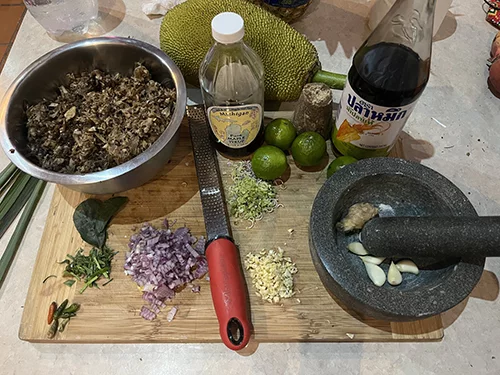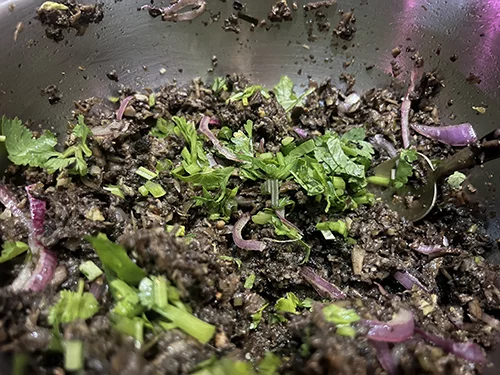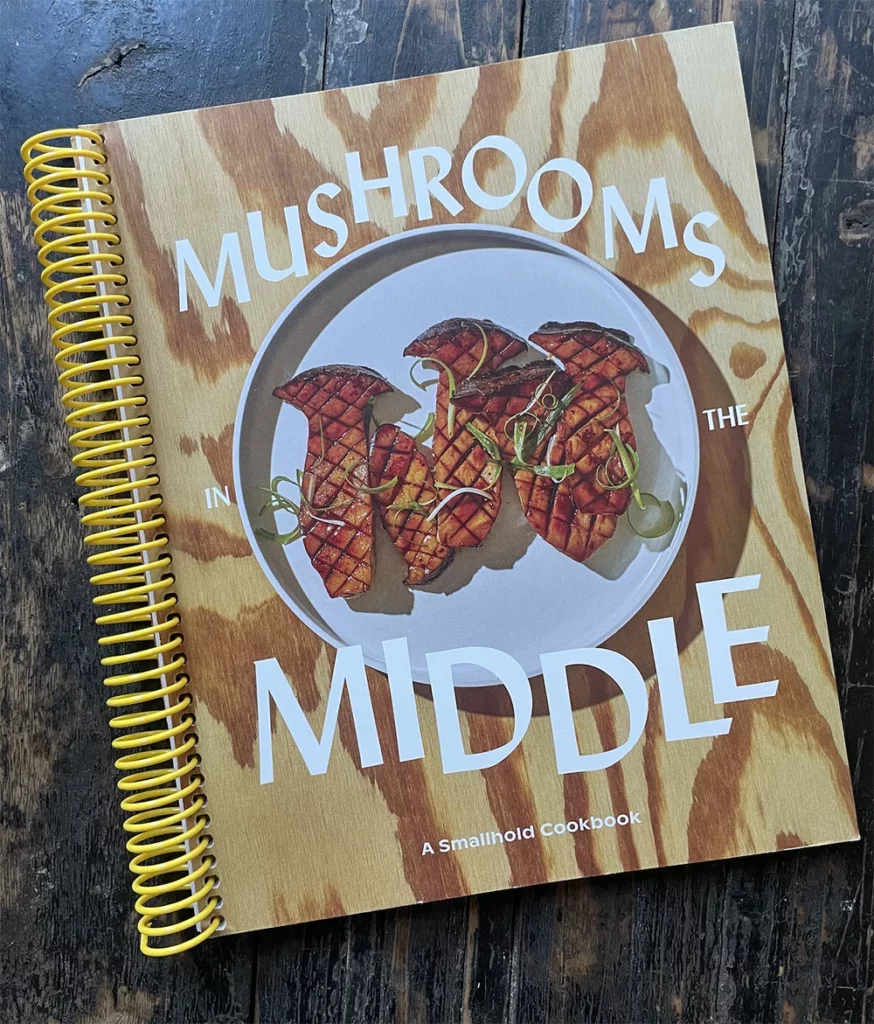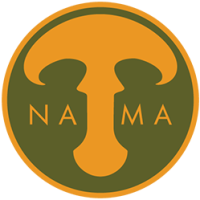Mushroom Cookbook Reviews
Cooking with Mushrooms:
A Fungi Lover’s Guide to the World’s Most Versatile, Flavorful, Health-Boosting Ingredients
by Andrea Gentl
A Review By Zachary Mazi
I recently had the pleasure of meeting Andrea Gentl in La Mixteca, a large region in the North of Oaxaca State. Just outside of Tlaxiaco, my fiancé Kimberly and I had taken one of our Mexico Mushroom tour groups to “La Fiesta de los Hongos Mixtecos,” a two-day culinary-forward event in the woods featuring some of the best chefs in all of Oaxaca. During the foray, surrounded by wonderful vendors and all the normal things one might find at a mushroom festival. She and I connected on all things cooking, and of course the conversation drifted to this book, her most recent venture, after a career of food photography for some of the best chefs in the world, from her early day working with Julia Childs to a rather impressive client list including Bon Appetit, Martha Stewart Living, Ten Speed Press and Haagen Dazs, to name only a few.
Like many of us that have been immersed in the world of fungi for more than a decade or two, Andrea’s passion for mushrooms has been quietly growing under the ground and now that it is hard to glance anywhere without seeing the hyper-trending topic of fungi, she is emerging into the sunlight with an absolutely fantastic addition to the mushroom cookbook pantheon.
Cooking with Mushrooms is organized into seven easy-to-understand and progressive chapters: Chapter 1: The Mushrooms, an brief introduction to mushrooms, which includes not only instructions for drying and making mushroom powders (which feature extensively throughout the rest of the book), and a few tips for growing mushrooms at home (with purchased kits) with limited, but pertinent fungal terminology–perhaps the only technical part of the book–along with a detailed description of the 20 cultivated and wild mushrooms she uses; Chapter 2: Always on Hand in the Larder (what I would consider to be the mycelial foundation of the book) provides fabulous and inspiring ideas for utilizing both fresh and dried mushrooms to create her pantheon of pantry basics. These brilliant pieces are subsequently assembled and brought to life in the rest of the book: mushroom powder mixes, adaptogenic honey, broths, condiments, sauces, mushroom powder-enhanced nut butters, and delicious (non-mushroom) accompaniments, and so much more. The body of the book is made up of four chapters consisting of dishes, arranged by time of the day: Chapter 3: Mushrooms in the Morning, Chapter 4: Midday, Mushrooms, Chapter 5: Mushrooms for Cocktail Hour, & Chapter 6: Dinner from Mushrooms; and a final chapter to sweeten the deal: Chapter 7: The Sweetest Mushrooms creative desserts and sweets that will surprise even the avid mushroom enthusiast with new sweet uses for otherwise savory mushrooms. These five chapters are packed with incredibly simple yet creative recipes, seamlessly blending several global cuisines while remaining firmly rooted in her Italian kitchen upbringing.
Choosing a recipe for this review, however, posed no problem. Having spent an unexpected 1.5 years in Thailand during the first part of the pandemic, Andrea’s Mushroom Larb (p. 122) was an irresistible choice. “Larb” (or Laap) means minced, and this dish from the Isan region of Thailand is generally minced pork, boiled gently, with garlic and spices, and drenched in lime and fish sauce, tossed with fresh shallots, plenty of chilies, cilantro or mint, served in lettuce or cabbage cups. We ate Larb just about every single day we lived in Thailand. As with all recipes in her book, Andrea bends her version with her own additions–maple syrup instead of palm sugar, olive oil, ginger and chili-garlic sauce (sambal)–found in any Asian market (the other Sriracha)–and of course mushrooms instead of meat, in this case Agaricus bisporus. I also used some 5-year old Queen boletes from my pantry, as well as some of this year’s dehydrated Amanita basii from the mountains of Oaxaca in addition to the cremini. For me personally, and this has nothing to do with Andrea’s masterful recipe, I do prefer the meat version of this dish, primarily because it is a clean acidic and chile dish… however, Laap Muang, the Northern Thai version of Larb, would actually be perfect for this crafty method of both sauteing and then oven-dehydrating the mushrooms, as it plays more into the deep and umami character that the mushrooms impart. I will definitely make this dish again, but will wait until chanterelle season to use a mushroom that when cooked has more of the boiled-pork appeal than the meaty and wet-soil tasting cooked cremini.


There are several elements to this wonderful compendium that are quite surprising. First, this is not a book about wild mushrooms, and though she does feature several (chanterelles, porcini, morels, truffles and matsutakes) in her recipes, she is very clear that, as the title suggests, this book provides a guide and personal experience on how to cook with regularly available mushrooms, and use them on an everyday basis, from granolas to infused liquors (including mezcal, of course). She emphasizes that harvesting wild mushrooms must be learned elsewhere. Second, this book does not delve into mycology at all. In fact, she does not include the Latin binomial names of fungi anywhere in the book, even for the medicinal mushrooms, which she seamlessly incorporates. Third, I loved that these not-normally-considered-culinary mushrooms are used in her kitchen larder without skipping a beat: reishi, chaga, and turkey tail mushrooms, used in powdered form, appear throughout her dishes. Unlike most appearances of these adaptogenic fungi, she details the flavors and includes them as crucial parts to the overall recipes.
Andrea’s familiarity with all aspects of cooking give this book an authority without ever seeming out of reach, and her recipe selection reveals a true mastery of flavor and diversity of global tastes. As a chef myself, what stood out to me the most was her ability to communicate not only the ease of gourmet home cooking, but also her own style and flair clearly honed while working with literally the most gifted food artists in the world over the course of her career. Trying not to be too effusive, I simply loved this book: each recipe is accompanied by her and her husbands elegant and simple photography using her own serving ware, and capturing the essence of each dish, often in a single photograph. This book is a must have for any home cook, and I dare say, for any mushroom enthusiastic chef as well.
“Mushrooms in the Middle: A Smallhold Cookbook”

Review by Jess Starwood
Mushrooms take the center stage in this brief, yet beautifully designed cookbook produced by Smallhold mushroom farms. The ten recipes are inspiring yet approachable for folks who may be new to cooking with fungi. As the growing mushroom farm aims to increase their product availability to consumers across the country, this cookbook serves as an approachable start to entice home cooks to experiment with fungi as the focal point in a dish.
Some of the standout and enticing recipes in this collection of recipes are the “Caramelized Mushroom Steaks” by Amanda Ahmad, the “Royal Trumpet Chorizo Hash” from Chef Tara Thomas or the “Forager’s Pie” contributed by Giulianna Furci, founder of the Fungi Foundation. Or, if you fancy something sweet, the “Salted Caramel-Shiitake Mousse” may be a curious culinary adventure.
The book prominently features mushrooms as the main ingredient and the focus of every dish with recipes highlighting the types of fungi that Smallhold grows—king oyster, shiitake, oyster, and maitake. While you won’t find a recipe for cooking with your foraged chanterelles, it does give you a few ideas on how to work with the mushrooms that the farm produces and offers. The book, along with the company’s hopeful message of changing the world through fungi, promotes swapping out animal proteins for mushrooms. Many dishes presented are vegan— meatless with no diary or eggs—and the rest are vegetarian, ensuring that the mushrooms take the center stage in each dish. Additionally, the mushroom flavored drink recipes were a pleasant surprise such as the “Shiitake Bloody Mary” and “Umami Grog.”
The charming retro design brings a refreshing, yet stylized look to bring this unique collection of delicious mushroom forward recipes in order to earn a place on the cookbook shelf. The price may be a little steep for a spiral bound collection of ten recipes, but the proceeds go directly to the Fungi Foundation to support their dedication to fungi conservation and education. See smallhold.com for purchasing.

NAMA Store >